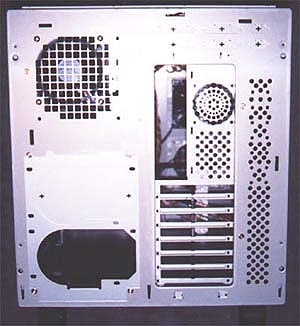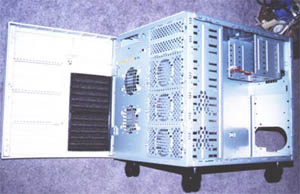Getting your components into a case is often where the
flaws of one design shine through.
This case fairs pretty well in that department. To install
the motherboard a removable tray slides off of the partition, making it a
pretty easy job to do.
| Up to (7) slots can be used (PCI, ISA, AGP, etc.), and
there are punchouts for two each of SCSI, Parallel and Serial
ports. |
 |
While the specs list (6) HDD that number is a bit skewed, with a FDD, that
number is realistically (5) devices. (8) CDROMs could be installed, or with 3.5"
to 5.25" adapters, (7) SCSI drives. To summarize the realistic number of drives
that can be installed in this puppy is something around 12. That is potentially
a lot of storage.
Installing the drives using the rail system is not difficult once the correct
holes have been used to attach the rails. Curiously the rails we got were
plastic with little grounding strips. We noticed that removing devices with these type
of rails was a bit difficult.
There are two racks, on for FDD and a HDD, and another for just HDD, each of
those must be unscrewed from the case to install the drives, but installing them
is easy, as the rack hangs off a little clip so screwing it back in is simple.
The HDD rack measures 5.5" high, and the CD-ROM rack 15".

There are two cable passthroughs, each about the size of a hand hold. I
would have liked to have seen these a little bit larger. With only two devices,
and a the power leads they are already quite crowded.
The little things
The little things usually pass or fail a case in my
book. One of the most important aspects of case design for me is rounded edges.
I've been cut too many times on the edges of razor sharp metal to ignore this
little quirk. The Net Server gets perfect 10's. On each side, the top and bottom
edges (where hands are most likely to go) have a 0.25" bend of metal, that makes
and excellent grip when rolling the case around while work is being done on it.
Apart from that, all exposed edges on the case have been beveled, or the metal
folded over. Except the knockout outs... Even the fan vents which standout about
a 0.25" have been punched from the front, so they are smooth if you happen to
brush your hand across them. From the looks of it, a lot off effort was put into
this case to ensure no one will ever get their finger sliced open by a razor
sharp
piece of computer case.
Another thing I have come to notice about cases, it the
grade of metal they use to build them. All the metal on this case is about 1mm
thick, and is well supported so that nothing wobbles, or bends when you attempt
to install a device.
I once had a case the felt like it was made from lead,
after installing a harddrive, the case almost had to be bent back to its normal
shape. That case would sway a lot with just a hand resting on top of it. I can
sit on this case, and wheel it around as a chair if I want and not be concerned
with wrecking
it. I like that.
The power switch is located behind a panel that can be
locked to prevent unauthorized use, and is easy to use, but the reset button
requires a pen or something similar to use. I find that just annoying, if I need
to reset the system the last thing I wan to do is go looking for a pen... I just
use the
switch on the powersupply.
